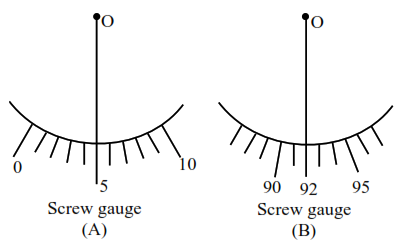Student A and Student B used two screw gauges of equal pitch and 100 equal circular divisions to measure the radius of a given wire. The actual value of the radius of the wire is $0.322 \mathrm{~cm}$. The absolute value of the difference between the final circular scale readings observed by the students A and $B$ is
[Figure shows position of reference 'O' when jaws of screw gauge are closed]
Given pitch $=0.1 \mathrm{~cm}$.

For (A)
Reading $=$ MSR $+$ CSR $+$ Error
$0.322=0.300+\mathrm{CSR}+5 \times \mathrm{LC}$
$0.322=0.300+\mathrm{CSR}+0.005$
$\operatorname{CSR}=0.017$
For B
Reading $=$ MSR $+$ CSR $+$ Error
$0.322=0.200+\operatorname{CSR}+0.092$
$\mathrm{CSR}=0.030$
Difference $=0.030-0.017=0.013 \mathrm{~cm}$
Division on circular scale $=\frac{0.013}{0.001}=13$
Comments
Click here to get exam-ready with eSaral
For making your preparation journey smoother of JEE, NEET and Class 8 to 10, grab our app now.
